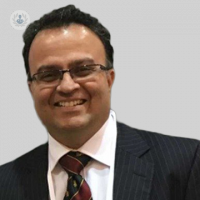How gastroscopy plays an essential part in GI diagnosis
Written in association with:The diagnosis stage for people with symptoms of upper gastrointestinal (GI) conditions, such as gastritis, polyps and structural abnormalities, involves a camera examination procedure called a gastroscopy. But how does it work?
Esteemed consultant surgeon Mr Vittal Rao, who specialises in upper GI and bariatric surgery, has put together a comprehensive guide to the process, answering questions about the conditions it diagnoses, the part gastroscopy plays in treatment and what the procedure involves.

Gastroscopy – what can it diagnose?
Gastroscopy is a camera examination of the upper part of the gut extending from the mouth to the beginning of the small bowel (Duodenum). A flexible camera probe, the size of an index finger, is passed via the oral cavity after numbing the back of the throat with a local anaesthetic spray with or without sedation. It assesses the upper part of the gut for any abnormalities including inflammation (gastritis, oesophagitis, duodenitis), lesions such as polyps, ulcers or cancers and structural abnormalities such as hiatus hernias or narrowing such as duodenal or pyloric stenosis and strictures of the oesophagus.
It is also used to find out causes of iron deficiency anaemia in middle-aged and elderly patients. Tissue samples (biopsies) can be taken at the time of the examination and these can be analysed by microscopic examination to help in making the final diagnosis.
Which persistent symptoms may need to be investigated by a gastroscopy?
Heartburn or reflux symptoms which do not settle down with medications should be investigated with a gastroscopy. This is particularly important in patients over the age of 45 to rule out sinister lesions. Patients with acid reflux which is not responding to medications need to undergo gastroscopy to rule out infection with H.pylori, a bacteria which causes excessive acidity.
If confirmed, this can be treated with antibiotics with complete resolution of symptoms. Difficulty in swallowing (dysphagia) should also be investigated on an urgent basis. Chronic cough which can be caused by reflux also should be investigated to rule out gastro oesophageal reflux disease (GORD).
Surveillance in Barrett’s oesophagus (a pre-cancerous condition) requires a gastroscopy and biopsy once every two years.
Which conditions can a gastroscopy confirm/diagnose?
Gastroscopy can confirm inflammatory conditions, ulcers, hiatus hernia, cancers and narrowing such as stenosis or strictures. It is also part of the work up to the diagnosis of complex disorders such as achalasia, GORD, Barrett’s oesophagus and coeliac disease. Biopsies taken during the procedure can help in confirming the diagnosis of the disorders mentioned above.
Can a gastroscopy also treat some conditions? How does it work?
Gastroscopy is used for therapeutic procedures, especially in emergencies such as bleeding ulcers, widening of a narrowing (dilatation of strictures) or stenosis and insertion of balloons for weight loss. Gastroscopy can also help in excision of small pre-cancerous lesions by techniques such as endoscopic mucosal dissection. New techniques such as endoscopic sleeve gastrectomy is used as a procedure for facilitating weight loss.
What can I expect on the day of having a gastroscopy?
The stomach needs to be empty at least four to six hours before doing the camera examination (gastroscopy). If the stomach is full of food residue, then small lesions and findings can be missed. So, you need to be on empty stomach for at least six hours. Also, if the stomach is not empty it can result in aspiration of food material into the respiratory tract, which manifests as aspiration pneumonia.
The procedure is done by numbing the back of the throat with a local anaesthetic spray. Sedation by administration of intravenous medication is also an option and can be used together with throat spray. This is helpful especially if you are anxious. The procedure takes about 15 minutes and once it is over, you are kept under observation for 30 minutes. You may experience some discomfort especially gas bloating as air is used to insufflate (inflate) the stomach to help in the detailed examination.
If you undergo sedation, you are advised to have a family member or friend to drive you home. You are allowed to drink and eat after an hour, once the effect of the throat spray wears out. The procedure is uncomfortable, but definitely not painful. If you have biopsies, again this is not painful.
Is gastroscopy a safe procedure?
Gastroscopy is a safe procedure which is done in an outpatient or day-case setting. As with any procedure, it is associated with complications which are fortunately very rare (1 in 10,000). This includes:
- Bleeding
- Perforation
- Reaction to sedative
- Damage to teeth
- Crowned teeth and dental bridge work
- Aspiration pneumonia (Very rare)
The complication of perforation is more likely to happen if you undergo therapeutic procedures such as dilatation (widening of a narrowing such as stricture or stenosis).
Looking for a specialist to advise you about upper GI symptoms, diagnosis procedures or treatment? Mr Rao can provide expert help. Visit his Top Doctors profile here to arrange an appointment.


